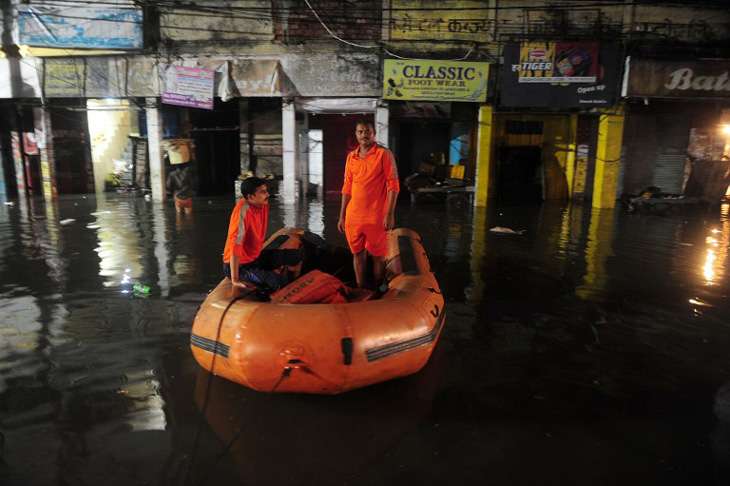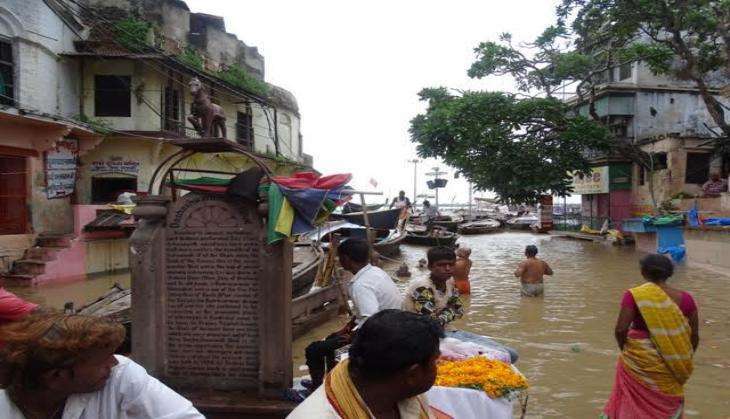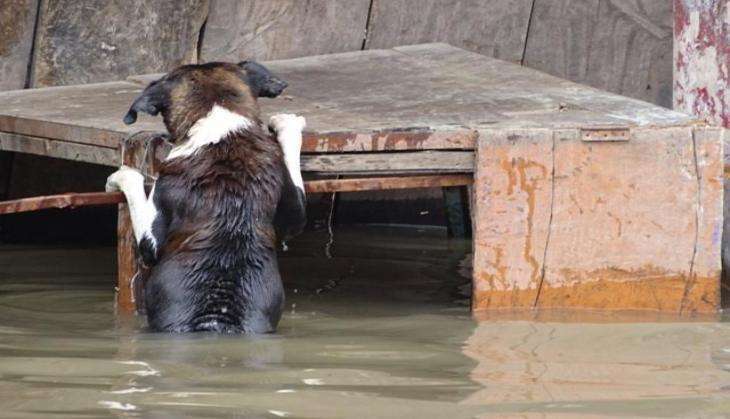Weak infrastructure and inadequate government response is making Varanasi drown

More 3 lakh people in Varanasi are reeling under the flood fury unleashed by the raging Ganga. The overflowing river is now threatening the central parts of the city.
More than 3,000 houses have been inundated in the holy city alone.
The roads of Varanasi are waterlogged leading to massive traffic congestions. Around 80,000 residents have been forced to move to safer locations in other parts of the city.
The worst flood since 1978 seems to have rattled the spirit of Varanasi, a city that is already coping with over population and illegal encroachments.

The government response
The fact that the region is represented by country's prime minister in Lok Sabha hasn't helped the matter as of now. Although, media reports suggest that Narendra Modi is closely monitoring the situation.
The public relations office of the prime minister is said to be active in overseeing the relief and rescue operations. The relief material from Gujarat is being distributed among the affected population.
Modi tweeted about the flood situation on Wednesday -
Deeply concerned by the flood situation in Varanasi. PMO is closely monitoring the situation & is in touch with with local authorities.
— Narendra Modi (@narendramodi) August 24, 2016
NDRF teams are present at Varanasi for rescue & relief work. The MP office there is working round the clock to provide all assistance.
— Narendra Modi (@narendramodi) August 24, 2016
These claims notwithstanding, the government efforts, particularly the health services, seems to be missing on ground.
"Mai Ganga is baar Banaras se naraaz hain, na jane kya kasoor hua hai? (Mother Ganges is angry with Varanasi this season. One doesn't know what is our fault?)," says Shiv, a local resident while sitting on the uppermost steps of the completely submerged Tulsi Ghat.
Shiv, like many of his cohabitants in the city, might be missing the point. For the present destruction cannot be blamed solely on nature's wrath. The failure of the successive governments and the city administration is equally responsible for the situation.

The problems with Varanasi
The Central as well as the state government has chosen to leave the planning of the fast growing city to providence. Now, when the devastating consequences are punishing the hapless people, their response is no different.
"The sewerage of the entire city flows into Ganga. It is now coming back to the city as the Ganga is breaching its banks. This was bound to happen," surmises PK Tripathi, a resident at the Assi Ghat.
Tripathi's lamentation is backed by scientific logic. The city's 150-year-old sewerage system is proving to be its nemesis.
The indiscriminate encroachment near the ravines merging in Ganga has added to the problem. The woes of the city appear to be far from over as the water level in Ganga shows no signs of receding.

Inadequate response
The Varanasi DM had ordered to close all educational institutes in the city till 25 August. However, there is no respite for lakhs of people who cross the river on a daily basis to make their ends meet.
Over 100 boats are currently plying in the city to ensure movement from one locality to another. But even this has proved to be insufficient.
"Our boss would not take floods for an excuse. He will deduct our salary. We have no means to cross Varanasi," complains Akhilesh, who works for a private company.
The health services remain a big challenge in flood-affected areas. Patients are pouring in BHU's Sir Sundarlal Hospital and Shiv Prasad Gupta Hospital. None of these hospitals have adequate facilities for emergency situations.
Experts fear the outbreak of infectious diseases once the Ganga comes back to its normal course. The main reason for this apprehension is flowing of sewerage on the roads along with the flood water.

Varuna River also wreaking havoc
Besides Ganga, Varanasi's another major river Varuna is also flowing above the danger mark. Over 500 houses along the banks of this river have been submerged.
It is worth mentioning that the Chief Minister Akhilesh Yadav has shown special interest in developing a tourism corridor alongside Varuna river.
In reality, the whole region along Varuna's banks has been a hotbed of the land mafia. The mushrooming of multi-storey buildings before and after the initiation of the corridor project near the river is now taking its toll.
Food packets have been distributed in only some of the affected areas. The locals are complaining that the food being distributed is hardly worth eating.
It is only the camaraderie among the common citizens that is coming to the real aid of the distressed people. But, Varanasi needs much more. If the city had a voice it would definitely be screaming for help from Modi.
(With inputs from Patrika UP Bureau)
Edited by Jhinuk Sen
Also read: In Pictures: Several districts reeling under a flood-threat in Uttar Pradesh
Also read: Shankarcharya Swaroopanand can't shut-up, now says floods connected to honeymooners
First published: 25 August 2016, 11:14 IST




![BJP's Kapil Mishra recreates Shankar Mahadevan’s ‘Breathless’ song to highlight Delhi pollution [WATCH] BJP's Kapil Mishra recreates Shankar Mahadevan’s ‘Breathless’ song to highlight Delhi pollution [WATCH]](https://images.catchnews.com/upload/2022/11/03/kapil-mishra_240884_300x172.png)

![Anupam Kher shares pictures of his toned body on 67th birthday [MUST SEE] Anupam Kher shares pictures of his toned body on 67th birthday [MUST SEE]](https://images.catchnews.com/upload/2022/03/07/Anupam_kher_231145_300x172.jpg)






